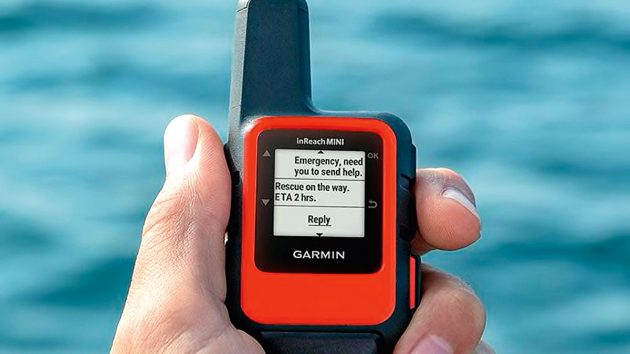Rupert Holmes looks at the advances of sat comms and how they are becoming more affordable for the average boater
Developments in satellite communications used to move at a glacial pace, but the landscape is now changing rapidly.
This started with small devices that bring sat comms to a much wider audience.
Many UK anchorages and estuaries have little or no mobile phone reception, so even if you never sail abroad these devices are still useful for keeping in touch.
Some provide only GPS tracking, plus limited one way text-based messaging to raise an alarm if you have a problem.
Others are black boxes that interface with a smartphone to provide tracking and two-way text messaging akin to the 160 character text messages of old.
Examples of the latter include ACR’s Bivy Stick and Garmin’s inReach Mini 2.
These cost around £230 and £380 respectively, with subscription plans from £12-14 per month. Battery life is a useful 5-7 days, depending on the device.
The pros and cons of satellite communications
The SPOT X has a mini qwerty keyboard, in much the same manner of old Blackberry mobile phones, but it runs on the Globalstar network, which lacks worldwide coverage.
It will suit the needs of some users, but at the moment won’t work for an Atlantic crossing, or in most of the popular Caribbean sailing areas.
These units also typically have an SOS function, usually accessed via a dedicated hard button that doesn’t need the smartphone interface.

ACR 4601 Bivy Stick
Price: US$249.95
Contact: bivy.com
However, it doesn’t connect to the coastguard, so they’re not a replacement for the standard methods of signalling distress at sea, or a full-on satellite phone.
It’s easy to see this type of satellite communication could have safety benefits.
Kirsten Neuschäfer’s recent rescue of Tapio Lehtinen in the Golden Globe Race demonstrated the extent to which being able to communicate from a liferaft is helpful in achieving prompt rescue.
Continues below…
Best satellite phones: What to look for when buying a satphone
Some, such as the Thuraya SatSleeve Plus, transform your own phone into a satellite device, while Iridium Go works with…
Tips for keeping your satellite phone in good condition
Test it monthly... at least
Offshore sailing gear: What safety equipment do you need for a rally?
The organisers, World Cruising Club (WCC), have strict safety requirements for participants and check all boats’ offshore sailing gear before…
SSB radio explained: The budget rival to satellite phone connectivity
These days it’s relatively easy to maintain phone contact almost anywhere in the world – but to do so from…
On the downside, there’s no standalone mode, so I pack an old handheld Inmarsat iSatphone Pro satellite phone in the grab bag.

Iridium Go!
Price: £1,185
Contact: iridium.com
A big part of the IridiumGO!’s success lies in a marketing decision to provide an all-you-can-eat data plan for US$150 per month.
Granted you can’t chew through much data at 2.4kbps, but it’s reassuring to know you’ll never run out mid passage, or land a colossal bill.
Two new Iridium voice, data and messaging systems – the Certus 100 and 200 – launched in the past 18 months and represent arguably the biggest step change in satellite communications for the past 20 years.
I used a Certus 200 racing round Britain and Ireland last summer.
Data speeds of 176kbps are enough to browse the internet, upload images to social media and download satellite weather pictures that helped us predict the timing of complex weather systems.

SPOT X
Price: US$249.99
Contact: findmespot.com
Standby power drain is minimal and the antenna will fit in the palm of your hand, so it’s a game-changer for smaller boats.
But it is possible to use huge amounts of expensive data.
The latest development puts the Certus 100 hardware (with 22kbps/88kbps upload/download speeds) into a standalone unit called the IridiumGO! exec.
This offers far more capability than the original (which remains on sale) including a built-in speaker and microphone, allowing it to be used in a standalone mode.
It is also the most economic ‘high speed’ option, with the hardware costing US$1,600 (ex VAT) and monthly data/airtime plans from US$110 (though there’s no unlimited data option).
New players
Elon Musk’s Starlink satellite broadband system offers dazzlingly fast speeds, even by terrestrial standards, for only £75 a month and many sailors are successfully using it afloat.
However, coverage is far from universal and some enthusiasts are using the kit outside its terms and conditions.
Not all restrictions have been enforced to date, but that may change in the future.
Therefore, while the system is a great match for some boat owners, it’s not yet one to be recommended for safety critical purposes at sea.
The pace of change continues to accelerate. Apple has partnered with Globalstar to bring one-way SOS level satellite connectivity to the version of the new iPhone 14 sold in the USA and Canada.
Equally, Iridium has signed a more wide ranging deal with Samsung to enable two-way text messaging, and photo transmission, for its Galaxy S23 smartphone.
Enjoyed reading Cheaper satellite communications: a buyers guide?
A subscription to Practical Boat Owner magazine costs around 40% less than the cover price.
Print and digital editions are available through Magazines Direct – where you can also find the latest deals.
PBO is packed with information to help you get the most from boat ownership – whether sail or power.
-
-
-
- Take your DIY skills to the next level with trusted advice on boat maintenance and repairs
- Impartial in-depth gear reviews
- Practical cruising tips for making the most of your time afloat
-
-








